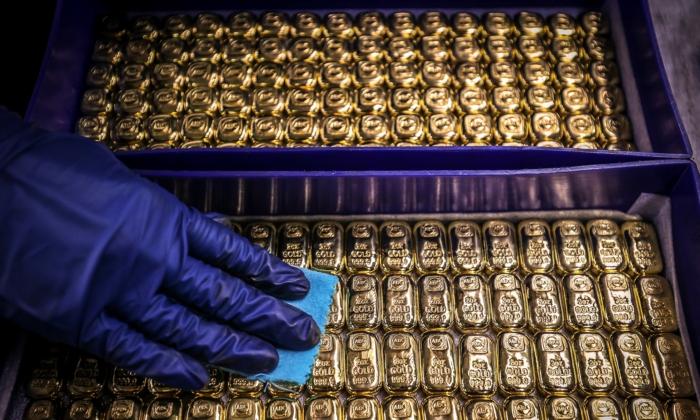A cooling inflation rate would act as an incentive for the Federal Reserve to cut interest rates, potentially increasing gold prices.
Gold prices increased during early trade on Thursday ahead of U.S. inflation data and amid geopolitical tensions, breaking away from a multi-day downward trend.
Gold futures were
trading at $2,038 per oz. on Jan. 11 as of 03:30 a.m. ET, up from its opening price of around $2,030 per oz. The upsurge came after four days of continuous decline.
Investors are now awaiting the release of the Consumer Price Index (CPI)
data for December by the U.S. Census Bureau on Thursday morning, which will reveal how inflation has fared since November. The 12-month
inflation in November came in at 3.1 percent.
With the “U.S. CPI looming, [gold] bears may be taking a cautious approach and lightening their load ahead of the event,” Matt Simpson, a senior analyst at City Index,
told Reuters. Economists polled by the outlet expect inflation to be 3.2 percent in December.
A cooling inflation rate would act as an incentive for the U.S. Federal Reserve to cut its elevated interest rates. And with declining rates, the prospects of
gold prices heading up increase.
Investors are
betting on a 140 basis points (bps) reduction in interest rates by the Fed this year, with a 69 percent chance that the cuts could begin in March, the outlet said citing data from the London Stock Exchange.
“While Fed cuts seem likely, 140 bps could still be overly optimistic in my view. Core CPI is still roughly twice the Fed’s target and employment data remains strong,” Mr. Simpson said.
Geopolitical
tensions are also providing support to gold prices as the conflict in the Middle East pushes investors to park their money in the yellow metal as a safe haven.
In a Jan. 10
update, the World Gold Council (WGC) noted that elevated geopolitical risk was a “key driver” to gold prices in 2023, adding an estimated 5 percent in returns and mitigating the downside from declining inflation.
“Financial conditions have eased markedly on the back of the bond market rally but market expectations of policy rate cuts seem excessive—a concern some Fed officials have voiced since the December meeting—and the tensions around the Suez Canal have highlighted how continuing geopolitical factors can have swift inflationary (cost-push) implications,” WGC said.
“Although we still view a material resurgence of inflation as a remote possibility, this scenario would likely be positive for gold, as it undermines monetary policy and risks an even harder landing further down the road.”
In addition to geopolitical risks, gold prices were also boosted by central bank buying, which the WGC estimates contributed to 10 to 15 percent of the price increase last year.
“In the near term, a tug-of-war between historically positive January seasonality and some pushback against the dovish sentiment that drove prices to all-time-highs in December is likely,” the council said.
2024 Prices
For 2024, most experts predict gold prices to keep rising. In a Jan. 9
post, Ole Hansen, head of commodity strategy at Saxo Bank, predicted gold prices hitting a record high of $2,300 this year.
“With ETFs, demand is likely to return, and with central bank demand continuing, potentially supported by a weaker dollar,” gold prices could hit that level, he stated.
JP Morgan predicts
gold to see a “breakout rally” starting in the middle of this year due to the Federal Reserve’s interest rate cuts. The bank expects gold to hit a peak of $2,300. Meanwhile, UBS projects gold prices to hit $2,150 by the end of this year if the rate cuts were to take place.
Speaking to CBS News, Liam Hunt, a financial writer and analyst for Gold IRA Guide,
said that gold prices tend to rise when inflation rates increase.
“If current trends of economic uncertainty and inflationary pressures continue, there could be upward pressure on gold prices. In 1980, gold prices reached a then-record $800 per ounce following years of generationally-high inflation over the preceding decade,” he said.
In 2023, “fears that an uncontained, regional war could disrupt global markets and supply chains triggered capital flight into gold and away from speculative assets such as high-risk stock.”
There are also downside risks to gold. In an
interview with Yahoo Finance last month, Rob Haworth, senior investment strategy director at U.S. Bank Asset Management Group, noted that lower interest rates and investor hopes for Fed rate cuts have contributed to surging gold prices.
“A key question for bullish gold investors is whether these trends can be sustained. A still-growing U.S. economy and few signs the Fed is close to considering interest rate cuts are likely to temper near-term enthusiasm for gold,” he said.
Central bank
buying could once more play a key role in gold prices. Even if these banks do not purchase gold in the same quantities as last year, they could still buy 450 to 500 tons in 2024, which “should provide an extra boost” to prices, the WGC
said in its 2024 outlook report.
“Furthermore, the probability of a recession is not insignificant. From a risk-management perspective, this would provide strong support to the case of maintaining a strategic allocation to gold in the portfolio,” it said.







